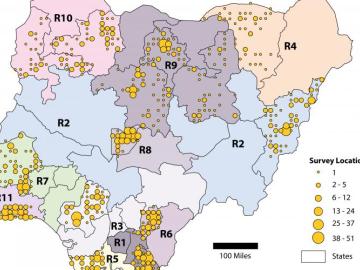
Filter News
Area of Research
- Biology and Environment (5)
- Clean Energy (21)
- Climate and Environmental Systems (2)
- Computer Science (1)
- Energy Sciences (1)
- Fusion and Fission (1)
- Fusion Energy (4)
- Isotopes (2)
- Materials (15)
- Materials for Computing (1)
- National Security (5)
- Neutron Science (5)
- Nuclear Science and Technology (5)
- Nuclear Systems Modeling, Simulation and Validation (2)
- Supercomputing (6)
News Type
Date
News Topics
- 3-D Printing/Advanced Manufacturing (4)
- Advanced Reactors (6)
- Artificial Intelligence (2)
- Big Data (3)
- Bioenergy (1)
- Biology (3)
- Biomedical (9)
- Chemical Sciences (2)
- Climate Change (5)
- Computer Science (9)
- Coronavirus (7)
- Energy Storage (9)
- Environment (10)
- Frontier (1)
- Fusion (5)
- Grid (4)
- Isotopes (2)
- Machine Learning (3)
- Materials Science (9)
- Mathematics (1)
- Microscopy (3)
- Molten Salt (1)
- Nanotechnology (3)
- Neutron Science (6)
- Nuclear Energy (9)
- Physics (7)
- Polymers (2)
- Security (1)
- Summit (5)
- Sustainable Energy (8)
- Transportation (4)
Media Contacts

Pauling’s Rules is the standard model used to describe atomic arrangements in ordered materials. Neutron scattering experiments at Oak Ridge National Laboratory confirmed this approach can also be used to describe highly disordered materials.

Planning for a digitized, sustainable smart power grid is a challenge to which Suman Debnath is using not only his own applied mathematics expertise, but also the wider communal knowledge made possible by his revival of a local chapter of the IEEE professional society.

When Sandra Davern looks to the future, she sees individualized isotopes sent into the body with a specific target: cancer cells.

Growing up in Florida, Emma Betters was fascinated by rockets and for good reason. Any time she wanted to see a space shuttle launch from NASA’s nearby Kennedy Space Center, all she had to do was sit on her front porch.

Oak Ridge National Laboratory scientists helped count the population of Nigeria – all without leaving the lab.

Irradiation may slow corrosion of alloys in molten salt, a team of Oak Ridge National Laboratory scientists has found in preliminary tests.

Scientists at Oak Ridge National Laboratory and the University of Tennessee designed and demonstrated a method to make carbon-based materials that can be used as electrodes compatible with a specific semiconductor circuitry.


Rufus Ritchie came from Kentucky coal country, a region not known for producing physicists.


